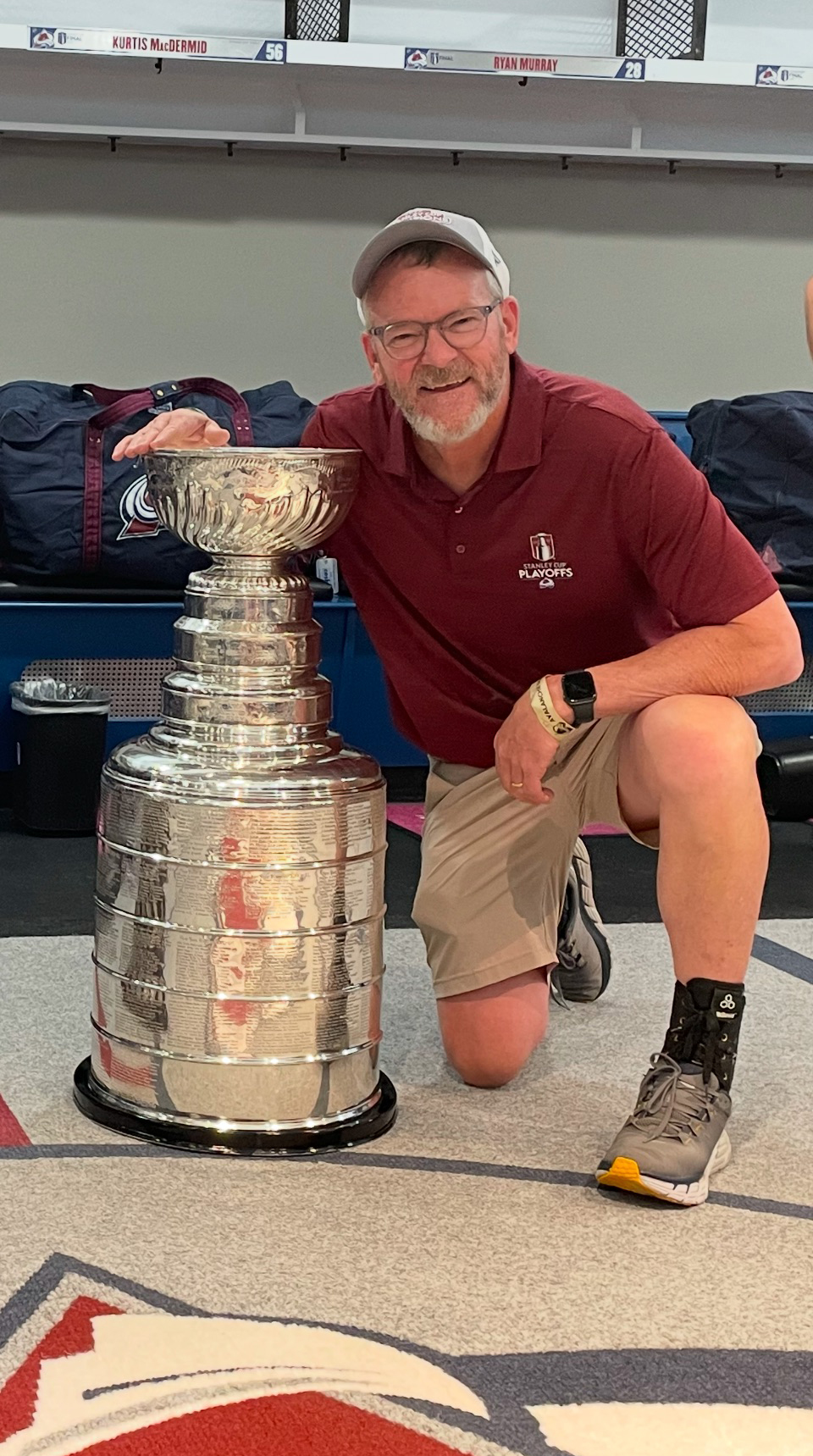From the Spring 2025 Journal of the Colorado Dental Association
By Becky O’Guin, CDA Director of Communications

Dr. Dan Selner with the Stanley Cup.
Getting into professional sports dentistry in Colorado is a bit of being in the right place at the right time, and having the demeanor and skill set to manage trauma. Several CDA member dentists provide treatment to Colorado’s professional lacrosse, hockey and football teams.
Not every game has a dental emergency, so sometimes team dentists get to watch the games. Dr. Daniel Selner, dentist for the Colorado Avalanche, has had a lifelong love for hockey. He started playing hockey when he was 10 years old and when he was 12, he wrote up a plan for his family to move to Canada so he could delve deeper into hockey. However, his parents did not move the family to Canada.
He became the team dentist for the Avalanche after meeting Dr. Andrew Parker (the team physician) when his daughter tore her ACL in high school. He recommended Dr. Selner to the team and as they say, “the rest is history.” Dr. Selner has been the Avalanche dentist for 12 years. “When I started, Nathan MacKinnon was a rookie and Patrick Roy was the coach. “It’s kind of wild that he [MacKinnon] is getting close to 30.”
Dr. Eric Rysner fell into volunteering with the Colorado Mammoth lacrosse team by chance after meeting their previous general manager in 2005. Dr. Rysner played outdoor lacrosse in high school. He said despite the intensity of play, being the team dentist isn’t as action-packed as people may think. “Most of the things I do are pretty preventative. I offer to make mouthguards — I would say about 10 to 15 percent of the team wears a mouthguard. I’m a volunteer and this is my 20th year with the team.” In addition to mouthguards, he has done some emergency ligation for teeth that have been luxated and is a resource for players who can come to see him in his office after the game.
Common dental injuries in sports include tooth (crown) factures, tooth intrusion, extrusion and avulsion, and temporomandibular joint dislocation.[i] Dr. Rysner says, “I’ve seen some significant luxations that we were able to stabilize at the Pepsi Center (now Ball Arena).” “I’ve done a few root canals from injured anterior teeth, fixed a lot of broken teeth with bonding and crowns and sutured about seven lips during my time.” Dr. Rysner has also provided dental treatment to opposing teams when needed.
Dr. Andrew Ricci and Dr. Matt Mauck are the dentists for the Broncos. And, while the practice has provided dental care for the Broncos since the late 80s, Dr. Ricci joined the practice 10 years ago. Dr. Mauck was a quarterback for Louisiana State University and won the national title. He was drafted by the Broncos and was a patient at the practice before he went back to CU dental school following his playing career. He then joined the practice after his graduation.
Sports-related dental injuries account for 40% of all dental injuries in the United States.[ii] This includes all sports related injuries, not just professional sports. Dr. Ricci said dentists need to understand flexible traumatology, restorative treatment and oral surgery to piece people back together in sports dentistry.
There are a few sports dentistry organizations like the Academy of Sports Dentistry that focus on traumatology, said Dr. Ricci. The American Academy of Endodontics and the International Academy of Dental Traumatology release some clear guidelines on how to handle trauma such as follow-up procedures for fractured permanent teeth and alveolar fractures. Dr. Ricci got his start in sports dentistry working with the sports teams at the University of Southern California where he went to dental school.
Being a dentist for a professional sports team can be stressful. Dr. Ricci said the niche timeframes needed to take care of injuries puts extra pressure on procedures that would otherwise be simple. “You have to think on your feet and handle somebody in crisis or trauma,” said Dr. Ricci. He said that between having to get players back on the field quickly, and doing high-quality work in a short timeframe on the sidelines requires him to be flexible in how he manages these events.
While some hockey and football players can get stitches and get back into the game right away, Dr. Ricci said that it is the players’ decision to stay out or go back into the game. “There are times when a player gets a chipped tooth or stitches and going back into the game isn’t going to make it worse.”
Hockey is known for its injuries and Dr. Selner has seen his fair share of them. He said his friends gave him grief because one of the NHL players he worked with didn’t have any front teeth. Dr. Selner pointed out that many players have implants placed but they choose not to have them restored until after their hockey careers are over.
Being a sports dentist has some nice benefits too. “I love the players; I get pretty attached to them,” Dr. Rysner said. “I love the excitement and going to the games; it’s something completely different than my day job. We get parking passes at Ball Arena, they give us clothing and season passes. It’s just been a lot of fun.”
Dr. Selner likes the perks of being a team dentist as well. “I get to meet and be on a first-name basis with a lot of cool people,” Dr. Selner said. They do a Christmas party every year down at Ball Arena and I get an invitation to take my family to those, which is fun. They don’t pay me, but I get four tickets to the games and my family is super into hockey. I even got to ride on top of the fire truck when we won the Stanley Cup and got a ring.”
“It’s fun; one of us is at the games in case something happens. We get to meet interesting people,” Dr. Ricci said. “To have people and organizations that are fans of our work … that’s fantastic. I take a lot of pride in what we do. The organization trusts us to get the work done the way they need it to get done. Trust goes a long way, and we value that.”
[i] Common Dental Injury Management in Athletes Eliot J. Young, MD, FAAFP, CAQSM eliot.young@christushealth.org, C. Roger Macias, DDS, FACD, and Lindsay Stephens, DO View all authors and affiliations Volume 7, Issue 3 https://doi.org/10.1177/1941738113486077
[ii] AMSSM Member Authors Jesse Shaw, DO and David Braun, M.D. https://www.sportsmedtoday.com/dental-injuries-va-244.htm#:~:text=Sports%2Drelated%20dental%20injuries%20account%20for%2040%%20of,are%20fast%20paced%20and%20have%20high%2Dspeed%20impacts.&text=Athletes%20can%20also%20experience%20bleeding%2C%20swelling%2C%20bruising%2C%20and%20redness%20of%20dental%20tissues%20and%20structure. Accessed 3/18/25.

